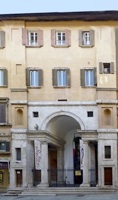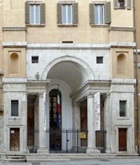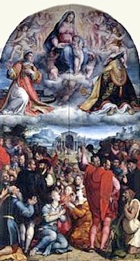


This was the site of the parish church of Santa Maria del Mercato (13th century). It was also known as Santa Maria de Foro, in reference to the Roman forum, which seems to have extended thus far. The church was used by a number of the city guilds (including the Collegio del Cambio until ca. 1360 and the Collegio della Mercanzia until 1390), and was the place in which the guilds’ representatives to the governing Priori took their oaths of office.
When the building of Via Nuova necessitated the demolition of this important church, Cardinal Tiberio Crispo commissioned Galeazzo Alessi to build the present church as a replacement. It was consecrated in 1548.
The church housed the Compagnia dei Sarti (tailors’ guild) and the Compagnia dei Muratori (masons’ guild) in the 17th century. The parish was merged with that of Santa Maria della Misercordia in 1760 and the church was deconsecrated in 1866. [It now serves as the “Borsa Merci”.]
Portico (ca. 1547)

Art from the Church
Santa Maria del Popolo Altarpiece (1548-9)

Giorgio Vasari, who records this commission, adds that Cristofano Gherardi, il Doceno “painted with his own hands all the upper part, which is indeed most beautiful and worthy of great praise”. There is no documentary evidence of this assertion, but it is supported on stylistic grounds. (The two artists had already worked together at Rocca Paolina).
-
✴In the upper part of the altarpiece, the Madonna is surrounded by angels and seated on a cloud. She holds the standing baby Jesus and is flanked by SS Herculanus and Laurence.
-
✴Below, the citizens of Perugia are assembled in front of a church in a landscape. While this church was probably meant to represent Santa Maria del Popolo, it is actually a direct quotation from a fresco (ca. 1525) of a scene from the life of St Catherine of Siena in Silvestro al Quirinale, Rome, which is by Polidoro da Caravaggio and Maturino da Firenze.

